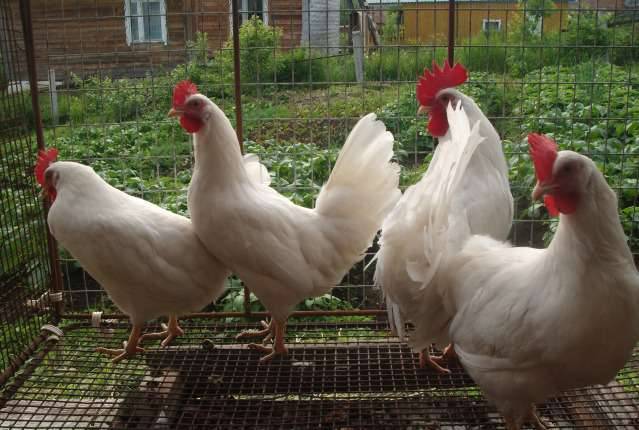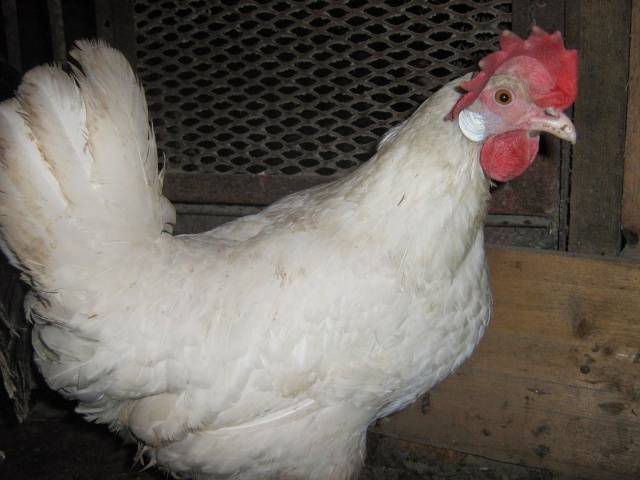Content
Leghorn chickens trace their origins to places located on the Mediterranean coast of Italy. The port of Livorno gave its name to the breed. In the 19th century, Leghorns came to America. Crossing with black minorka, with fighting chickens, Japanese ornamental chickens, gave results in the form of consolidation of such qualities of the breed as egg production and rapid maturation of young animals. Various breeding programs carried out under different environmental conditions eventually led to the development of a new breed with characteristic traits. Leghorns became the base breed on which other breeds and hybrids were formed.
The breed appeared in the Soviet Union in the 30s. At first it was used without any changes. Then domestic breeders began to develop new breeds based on Leghorns. Examples of domestic breeds, in the creation of which the genetic material of the Leghorn breed, Russian White breed, Kuchin anniversary.
Appearance
Description of the Leghorn chicken breed: the head is small in size, the comb is leaf-shaped, in roosters it is erect, in hens it falls to one side. Young chickens have dark orange eyes; with age, the eye color changes to light yellow.The ear holes are white or blue, the earrings are red. The neck is elongated and not thick. Together with the body it forms an elongated triangle. Wide chest and voluminous belly. The legs are thin but strong. Juveniles are yellow and adults are white. The plumage is pressed tightly to the body. The tail is wide and inclined at 45 degrees. Look at the photo to see what Leghorn chickens look like.
The colors of the plumage are white, black, variegated, brown, golden, silver and others. There are more than 20 varieties in total. White Leghorn chickens are the most common breed in the world.
Productivity
- Leghorn chickens are exclusively egg producing;
- The weight of Leghorn hens often reaches 2 kg, and that of roosters 2.6 kg;
- When they reach the age of 4.5 months, they begin to lay eggs;
- Sexual maturity occurs at 17–18 weeks;
- Each laying hen of the breed produces about 300 eggs per year;
- Egg fertilization is approximately 95%;
- The hatchability of young animals is 87–92%.
Breed Features
Poultry farmers of both large complexes and very small farms are happy to have Leghorn chickens. Breeding and subsequent keeping of chickens has economic benefits. The bird has positive properties that largely outweigh some of the disadvantages.
- Leghorns are non-aggressive, get used to their owners well, and have a good-natured disposition;
- They adapt well to living conditions and climatic conditions. The Leghorn breed can be kept both in the northern and southern regions. Russian winters do not affect the high productivity of poultry.
Content Features
They carry equally well when kept in cages and when kept on the floor.
Poultry houses should be equipped with perches, nests, drinking bowls and feeders. To arrange perches, it is better to use rounded poles with a diameter of 40 mm, so it will be more convenient for the hens to wrap their legs around them. There should be enough space for all chickens, since they spend almost half of their lives on the roost. Structural strength is a necessary condition. The perch should not bend and support the weight of several chickens.
Any container is suitable for arranging nests, as long as the laying hens fit there. For comfort, the bottom is lined with hay. In a private household, it is better to provide birds with an aviary for walking. To do this, fence off the area adjacent to the poultry house, be sure to stretch the mesh 1.6 meters high so that the birds do not have the opportunity to fly over. Otherwise, the birds can cause considerable damage to the farm. They will dig up the beds and peck at the vegetables. While walking, birds eat worms, beetles, and pebbles, which they need to grind food into their crops.
The responsibility of poultry farmers is to comply with sanitary standards when keeping chickens. Remove dirty litter and droppings in a timely manner. Chickens are small birds, but they can trample their droppings to stone. To avoid putting a lot of effort into cleaning the chicken coop, do it regularly.
The Leghorn breed has lost its brooding instinct. Therefore, it is recommended to lay eggs for hatching in chickens of other breeds or to use an incubator. Leghorns are unpretentious in their diet. The diet should include grains, bran, seasonal vegetables and herbs. Chopped nettle is very useful.In addition, the diet should contain food of animal origin: meat and bone meal, fish meal, curdled milk, cottage cheese. But, most often, these feeds are very expensive. The supply of calcium can be ensured in another way - by adding chalk, limestone, and crushed shell rock to the feed. You can also use special purchased mixtures for laying hens as vitamin supplements.
High egg production does not persist throughout the life of chickens. Its peak occurs in the 1st year of life; by the second year, chickens lay very few eggs. Experienced poultry farmers do not stop constantly updating their livestock every 1.5 years. In this way, the required number of maximally productive laying hens is maintained. Chickens over 1.5 years old are used for meat. For growing recommendations, watch the video:
Striped and Pied Leghorns
The Striped Leghorn was bred in the 1980s at the Institute of Farm Animal Breeding and Genetics in the Soviet Union. In the process of directed selection, the institute’s specialists carried out strict selection in the following areas: increased egg production, early puberty, egg weight and appearance of chickens. Striped and Pied Leghorns were bred with the participation of genetic material from an experimental group of Black and Pied Australorps.
The result was striped-pied leghorns with the following characteristics:
- Chickens of the egg direction. They lay 220 eggs per year. The shell is white or cream-colored, dense;
- They gain weight quickly. At the age of 150 days, young chickens weigh 1.7 kg. Adult chickens reach a weight of 2.1 kg, roosters - 2.5 kg;
- Sexual maturity in tabby leghorns occurs at the age of 165 days. Fertility of eggs is up to 95%, hatchability of chickens is 80%, safety of young animals is 95%;
- Resistant to diseases;
- The carcass has an attractive presentation. Which is very important for chickens of colored breeds.
Breeding work to improve and consolidate the highly productive qualities of striped leghorns continues.
Mini Leghorns
Dwarf leghorns B-33 are a smaller copy of leghorns. Bred by Russian breeders. Today they are in demand all over the world. With their miniature size: the average weight of an adult hen is 1.3 kg, a rooster is up to 1.5 kg, mini Leghorns have retained their high productive performance.
Dwarf Leghorn chickens are egg-laying. Laying hens produce up to 260 eggs per year, weighing about 60 g. The eggs are white with a dense shell. Chickens begin to lay eggs early, at the age of 4-4.5 months. Leghorn B-33 is distinguished by a high percentage of young animals being preserved - 95%. The breed is economically beneficial for breeding. Chickens are not picky in their choice of food and consume 35% less than their larger counterparts. But for full egg production, a high content of protein and calcium is required in the feed. With a high degree of egg fertilization of up to 98%, unfortunately, dwarf leghorns have completely lost their incubation instinct. Therefore, it is advisable to use an incubator on the farm. The Dwarf Leghorn breed is distinguished by its lack of aggression towards humans and each other, a high level of adaptation and adaptability to Russian climatic conditions. About the breed, watch the video:
Spotted Leghorn (Dalmatian)
They differ from ordinary leghorns in black and white coloring. The first chickens with this color appeared in 1904. They were considered an anomaly.However, they became the progenitors of spotted leghorns, which were not crossed with any other breeds. Perhaps the genes of the black minor had an effect, with the participation of which the Leghorn breed was developed. Spotted Leghorn chickens are good layers.
7
Loman Brown and Loman White
Poultry farmers who want to get even greater returns from their farm can be advised to choose the Loman Brown Classic breed. There are 2 subspecies of it: broken brown and broken white. The first was bred on the basis of the Plymouth Rock breed, and the second on the basis of Leghorns in the German farm Lohmann Tirtzucht in 1970. The breeding task was to develop a highly productive cross, the qualities of which would not depend on climatic conditions. The efforts of breeders have borne fruit. Today, Loman Brown crosses are in demand on farms in Europe and our country. Loman brown and loman white differ only in color: dark brown and white. Look at the photo for both subspecies.
At the same time, the product characteristics are similar: 320 eggs per year. They begin to lay eggs at 4 months. They do not require a lot of food and tolerate harsh Russian winters well. Most poultry farmers note the high economic benefits of keeping poultry.
Conclusion
The Leghorn breed has proven itself well on Russian farms. More than 20 large breeding farms are engaged in breeding the breed. In private farms, keeping and breeding the Leghorn breed is also economically profitable. It is important to observe the change of generations of chickens in order to maintain a high percentage of egg production.


















Hello, I'm from Kazakhstan, Dwarf Leghorn (B-33), how much does it cost? What are your prices?
whatsapp 8777 454 29 20